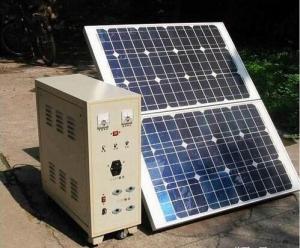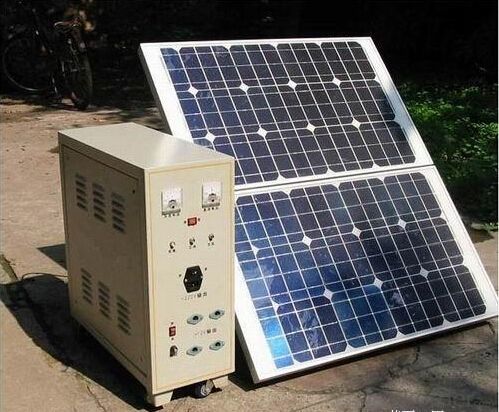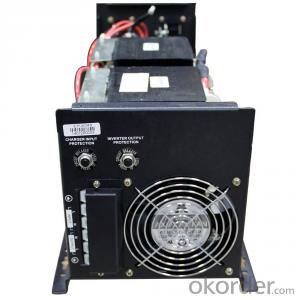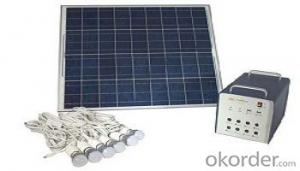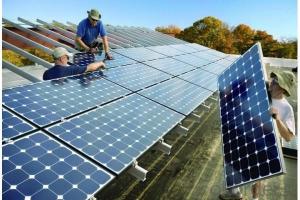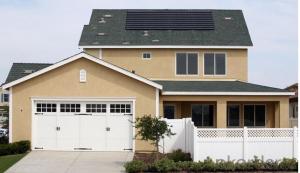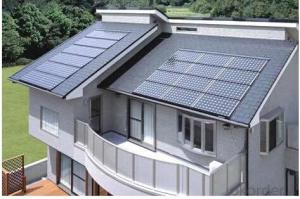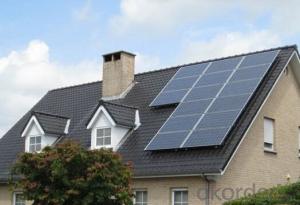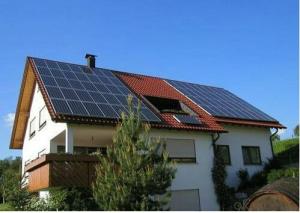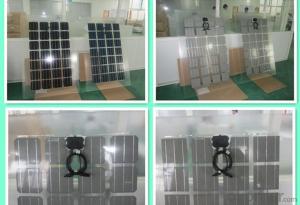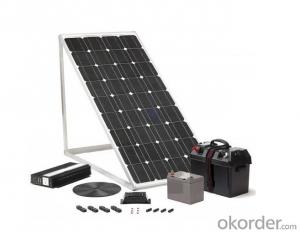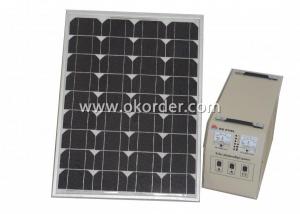Solar Energy Systems Omaha 60W Solar System Made in China
- Loading Port:
- China Main Port
- Payment Terms:
- TT OR LC
- Min Order Qty:
- -
- Supply Capability:
- -
OKorder Service Pledge
Quality Product, Order Online Tracking, Timely Delivery
OKorder Financial Service
Credit Rating, Credit Services, Credit Purchasing
You Might Also Like
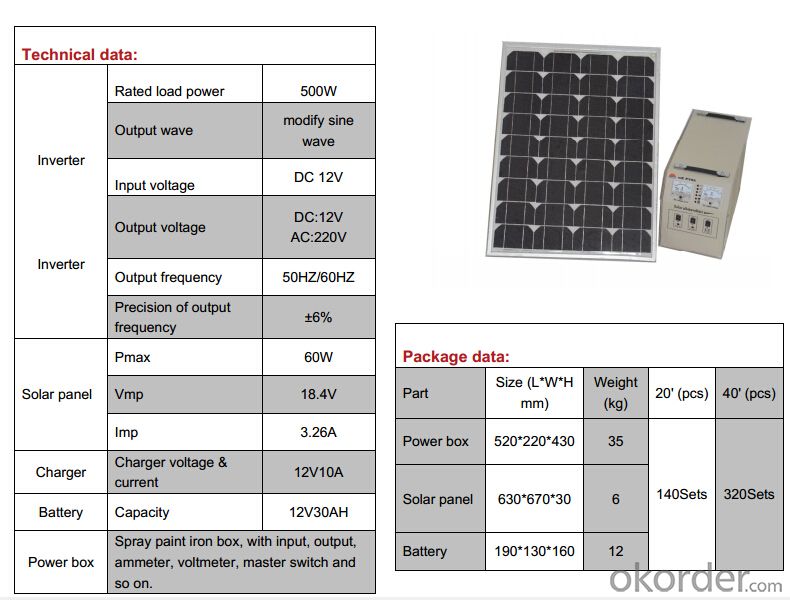
- Q: Can solar panels be installed on carports or parking structures?
- Yes, solar panels can be installed on carports or parking structures. This is known as solar carports, which utilize the space on top of carports or parking structures to generate solar energy. This not only provides shade for parked vehicles but also allows for the production of clean and renewable energy.
- Q: Can solar energy systems be used for powering amusement parks or entertainment venues?
- Amusement parks and entertainment venues have the potential to utilize solar energy systems for their power needs. Solar power has emerged as a viable and sustainable alternative to traditional energy sources, offering various advantages for large-scale operations like amusement parks. These venues consume a significant amount of energy, especially during peak operating hours. By installing solar panels, they can generate clean and renewable energy on-site, reducing their reliance on fossil fuels and minimizing their carbon footprint. This not only helps combat climate change but also promotes environmental stewardship and sustainability. Solar energy systems can be tailored to meet the specific energy requirements of amusement parks. The expansive roofs of buildings, parking lots, and other open spaces can be utilized to install solar panels, maximizing energy generation potential. Moreover, advancements in solar technology, such as thin-film solar panels and solar canopies, offer innovative solutions to seamlessly integrate solar power into the park's infrastructure. One of the key advantages of solar power is its ability to generate electricity during peak demand periods, which often align with the peak operating hours of amusement parks. This ensures a reliable and uninterrupted power supply, guaranteeing a smooth and enjoyable experience for visitors. Furthermore, solar energy systems can be combined with battery storage solutions. Surplus energy produced during the day can be stored in batteries and utilized during the evening or on cloudy days, ensuring uninterrupted power supply even when the sun is not shining. This enhances the reliability and resilience of the park's energy infrastructure. In addition to the environmental and operational benefits, solar energy systems can also result in long-term cost savings. Although the initial investment may be higher, the ongoing operational costs are significantly lower compared to traditional energy sources. The savings generated from reduced electricity bills can be reinvested into improving park infrastructure, enhancing visitor experiences, and expanding attractions. Amusement parks and entertainment venues have a unique opportunity to demonstrate their commitment to sustainability and renewable energy by adopting solar power systems. By harnessing the power of the sun, these venues can not only reduce their environmental impact but also inspire visitors to make more sustainable choices in their own lives. To summarize, solar energy systems can indeed be used to power amusement parks and entertainment venues. The multitude of benefits, including environmental sustainability, reliable power supply, cost savings, and the opportunity to promote renewable energy, make solar power an excellent choice for powering these large-scale operations.
- Q: What is the role of voltage regulators in a solar energy system?
- The function of voltage regulators within a solar energy system is to guarantee that the voltage output of the solar panels remains regulated and maintained within a specific range. Solar panels produce direct current (DC) electricity, which must be converted to alternating current (AC) in order to be utilized in homes and businesses. Nevertheless, the voltage output of solar panels can fluctuate due to varying factors such as sunlight intensity, temperature, and system load. Voltage regulators, also referred to as charge controllers, are responsible for stabilizing the voltage output of the solar panels. They constantly monitor the voltage level and make necessary adjustments to prevent overcharging or undercharging of the batteries or electrical loads connected to the system. By maintaining a consistent voltage, voltage regulators safeguard the batteries from potential damage caused by overcharging, which can reduce their lifespan. They also prevent undercharging, ensuring that the batteries are charged to their optimal capacity, thereby maximizing their efficiency and performance. Furthermore, voltage regulators play a critical role in safeguarding electrical devices connected to the solar energy system. They avert voltage spikes or surges that could potentially harm sensitive equipment like inverters or appliances. To summarize, voltage regulators are indispensable components in a solar energy system as they regulate and stabilize the voltage output of the solar panels, providing protection for batteries and electrical devices against potential damage.
- Q: Are there any tax credits available for installing a solar energy system?
- Yes, there are tax credits available for installing a solar energy system. The federal government offers a Solar Investment Tax Credit (ITC) which allows homeowners and businesses to deduct a percentage of the cost of installing a solar energy system from their federal taxes. As of 2021, the ITC offers a 26% tax credit for systems installed through the end of 2022. However, it is important to note that the tax credit will decrease to 22% in 2023 and will only apply to commercial installations. Additionally, some states also offer their own tax incentives for solar energy systems, such as tax credits, rebates, or exemptions. It is recommended to check with your state or local government to determine if there are any specific tax credits available in your area.
- Q: Can a solar energy system power an entire household?
- Yes, a solar energy system has the potential to power an entire household. However, the feasibility of completely powering a household with solar energy depends on various factors such as the size of the system, energy consumption patterns, and location. It is essential to assess the energy needs of the household, consider the available sunlight, and design an appropriately sized solar system to ensure sufficient power generation. Additionally, incorporating energy-efficient practices and technologies can further enhance the ability of a solar energy system to meet the household's energy requirements.
- Q: What is the impact of roof pitch on the performance of solar panels?
- The impact of roof pitch on the performance of solar panels is significant. The angle or pitch of the roof determines the amount of sunlight that the solar panels receive and the efficiency of their energy production. A roof with a steeper pitch can be advantageous as it allows the panels to capture more sunlight throughout the day. However, a pitch that is too steep may cause the panels to receive less sunlight during certain times of the day or year. Therefore, finding the optimal roof pitch for solar panels is crucial to maximize their performance and energy generation.
- Q: How much does it cost to install a solar energy system?
- The cost to install a solar energy system can vary depending on several factors such as the size of the system, location, type of panels, and installation complexity. On average, a residential solar energy system can range from $10,000 to $30,000 after considering incentives and rebates. It is recommended to get multiple quotes from reputable solar providers to determine the specific cost for your individual needs.
- Q: Are there any financing options available for purchasing solar energy systems?
- There exists a range of financing options for the acquisition of solar energy systems. One frequently utilized option entails obtaining a solar loan, which permits homeowners to borrow money specifically for the purpose of purchasing and installing a solar energy system. These loans generally present low interest rates and flexible repayment terms, rendering them an economical choice for many homeowners. An alternative financing option involves leasing a solar energy system. Through a solar lease, homeowners can have a solar energy system installed on their property without the need to pay for the equipment upfront. Instead, they make monthly lease payments to the solar company in exchange for utilizing the solar energy generated by the system. This option proves particularly popular among homeowners who prefer not to bear the responsibility of maintaining and repairing the equipment themselves. Moreover, certain states and municipalities offer solar incentives and tax credits to help mitigate the cost of installing solar energy systems. These incentives may include grants, rebates, or tax credits that reduce the initial costs associated with purchasing and installing solar panels. It is crucial to research the available incentives in your area, as they can significantly decrease the overall expense of adopting solar energy. Lastly, some solar companies provide power purchase agreements (PPAs), wherein homeowners pay for the solar electricity they consume at a predetermined rate. This option enables homeowners to benefit from solar energy without incurring any upfront costs, as the solar company owns and maintains the equipment. While PPAs may be a suitable choice for certain homeowners, it is imperative to carefully scrutinize the terms and conditions before entering into a contract. In conclusion, a variety of financing options are at hand for homeowners seeking to purchase solar energy systems, rendering the transition to clean and renewable energy sources more accessible and affordable.
- Q: Can solar energy systems be used in areas with limited access to solar monitoring systems?
- Yes, solar energy systems can be used in areas with limited access to solar monitoring systems. While solar monitoring systems help optimize the performance and efficiency of solar energy systems by providing real-time data on solar radiation, energy production, and system health, they are not essential for the functioning of solar energy systems. Solar panels can still generate electricity in areas with limited monitoring systems, as long as they receive sufficient sunlight. While the absence of monitoring systems may limit the ability to track and troubleshoot system performance remotely, solar energy systems can still be installed and operated effectively in such areas.
- Q: Can solar energy systems be integrated with other energy sources?
- Yes, solar energy systems can be integrated with other energy sources. In fact, this is a common approach in many applications to ensure a reliable and consistent supply of electricity. Solar energy is intermittent, as it depends on the availability of sunlight. Therefore, integrating solar energy systems with other energy sources, such as batteries or a power grid, can help to store excess energy generated during sunny periods and provide electricity when there is no sunlight. One popular method of integration is through the use of hybrid systems, where solar panels are combined with other renewable energy sources like wind or hydroelectric power. This allows for a more consistent and reliable energy supply, as different sources can compensate for each other's fluctuations. Additionally, solar energy systems can also be integrated with traditional energy sources like natural gas or coal-based power plants. This allows for the reduction of carbon emissions and the transition towards a cleaner and more sustainable energy mix. By combining solar energy with other sources, the overall energy generation capacity is increased, providing a more stable and secure energy supply. Overall, integrating solar energy systems with other energy sources is a practical and effective way to maximize the benefits of renewable energy while ensuring a continuous and reliable electricity supply.
Send your message to us
Solar Energy Systems Omaha 60W Solar System Made in China
- Loading Port:
- China Main Port
- Payment Terms:
- TT OR LC
- Min Order Qty:
- -
- Supply Capability:
- -
OKorder Service Pledge
Quality Product, Order Online Tracking, Timely Delivery
OKorder Financial Service
Credit Rating, Credit Services, Credit Purchasing
Similar products
Hot products
Hot Searches
Related keywords
